
State of the climate: Start of 2022 is the fifth warmest on record
Zeke Hausfather
04.27.22Zeke Hausfather
27.04.2022 | 8:00amAfter a slightly cooler 2021 on the Earth’s surface, the world is on track for 2022 to be somewhere between the fourth and eighth warmest year since records began in the mid-1850s.
It is very unlikely to be a record warm year due to moderately strong La Niña conditions in the early part of the year that are projected to continue for at least the next six months.
Not every year is expected to set a new record for the surface – and 2022 annual temperatures will likely end up well in-line with the long-term warming trend that the world has experienced over the past five decades.
The first four months of 2022 were the fifth warmest start to a year on record so far. March 2022 saw record warmth over China and large parts of southern Asia, as well as exceptionally high temperatures in the Arctic. In Antarctica, a March heatwave saw temperatures nearly 40C above normal in the eastern part of the continent.
Arctic sea ice currently is on the low end of its historical range, while Antarctic sea ice saw the lowest sea ice extent on record in late February.
Fifth warmest year on record so far
Global surface temperatures are recorded and reported by a number of different international groups, including NASA, NOAA, Met Office Hadley Centre/UEA and Berkeley Earth. Copernicus/ECMWF also produces a surface temperature estimate based on a combination of measurements and a weather model – an approach known as “reanalysis”.
The temperatures in the first three months of 2022 were the seventh warmest first quarter of the year on record, behind all of the past six years – but warmer than every year on record prior to 2015. The figure below shows how temperatures to-date compare to prior years in the NASA dataset. It shows the temperature of the year-to-date for each month of the year, from January through to the full annual average.
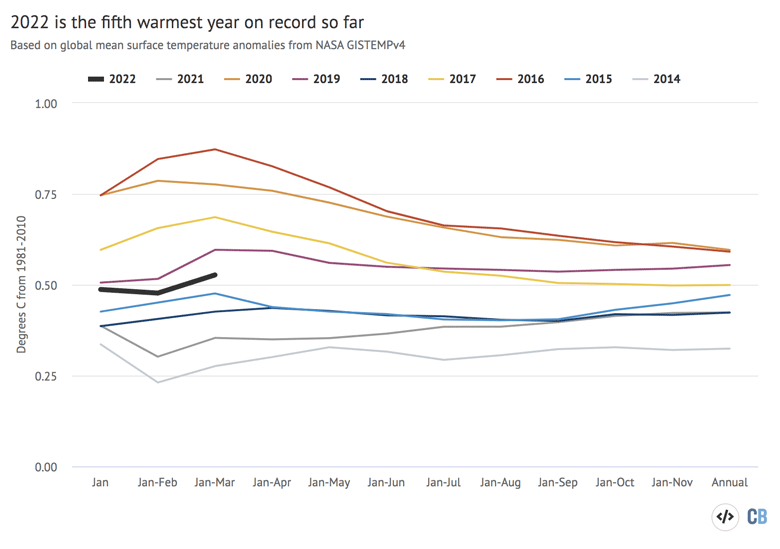
The table below shows the ranking of months in 2022 compared to the same month in all prior years since records began.
| NASA | Hadley/UEA | NOAA | Berkeley | Copernicus | |
|---|---|---|---|---|---|
| Jan | 6th | 6th | 6th | 6th | 6th |
| Feb | 6th | 9th | 7th | 8th | 6th |
| Mar | 5th | 5th | 5th | 5th |
January and March were the sixth and fifth warmest, respectively, across all the datasets. February was a bit cooler, coming in at somewhere between the sixth and ninth warmest on record.
The chart below compares the annual global surface temperatures from these different groups since 1970 – or 1979 in the case of Copernicus/ECMWF. The coloured lines show the temperature for each year, while the dots on the right-hand side show the year-to-date estimate for January to March 2022. Values are shown relative to a common baseline period – the 1981-2010 average temperature for each series. Surface temperature records have shown around 0.9C warming since the year 1970, a warming rate of about 0.19C per decade.
Year-to-date values are not yet available from Hadley/UEA due to reporting delays for March. The values in this chart will be updated when that data becomes available.
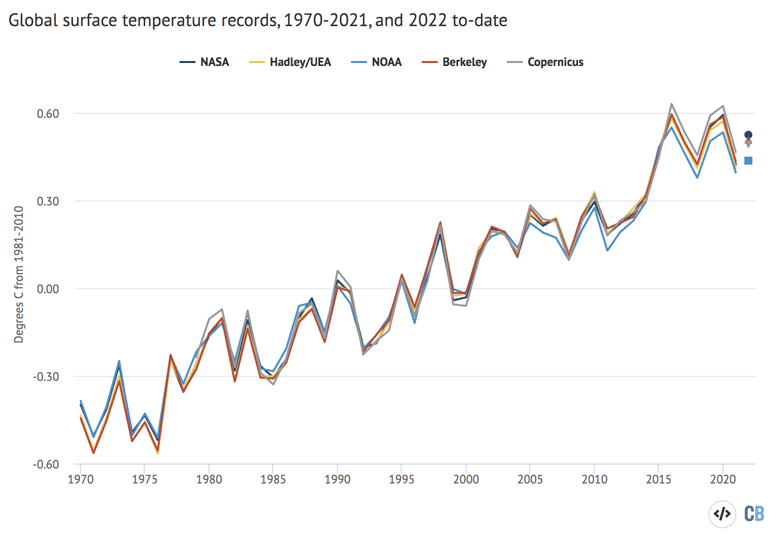
El Niño and La Niña events – collectively referred to as the El Niño Southern Oscillation, or ENSO – are the main driver of year-to-year variation on top of the long-term surface warming trend. ENSO events are characterised by fluctuations in temperature between the ocean and atmosphere in the tropical Pacific, which help to make some years warmer and some cooler.
The La Niña conditions seen in the early part of 2022 are likely to continue through the remainder of the year, though most models show a slight weakening of La Niña and the possibility of a “neutral” ENSO by the end of the year.
This can be seen in the figure below, which shows a range of ENSO forecast models produced by different scientific groups, with the average for each model type shown by thick red, blue and green lines. Positive values above 0.5C indicate El Niño conditions, negative values below -0.5 show La Niña conditions and values between the two represent ENSO neutral conditions.
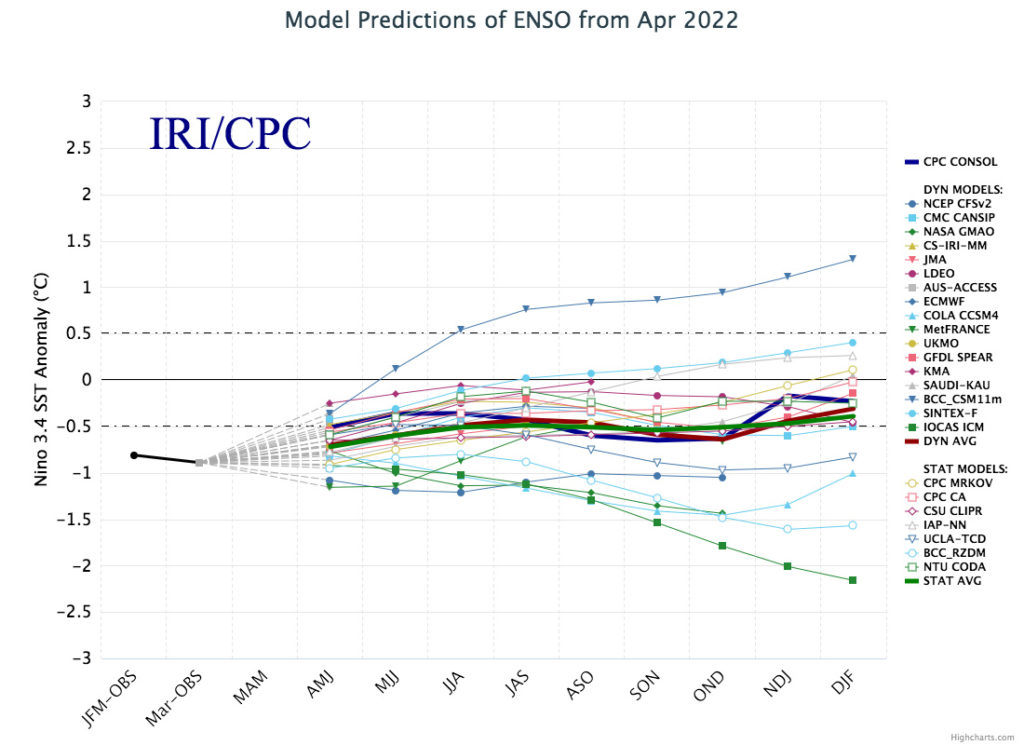
Global temperatures tend to lag behind ENSO conditions by a few months, so the current cooler global conditions may persist even after the La Niña event has ended.
Exceptional warmth in some regions
Despite only being the fifth warmest year on record to-date, 2022 has seen exceptional warming in a number of regions in the first quarter of the year, including record-setting heatwaves in both poles. As the map below illustrates, much of Asia, the Arctic and parts of the Antarctic saw particularly warm conditions in March.
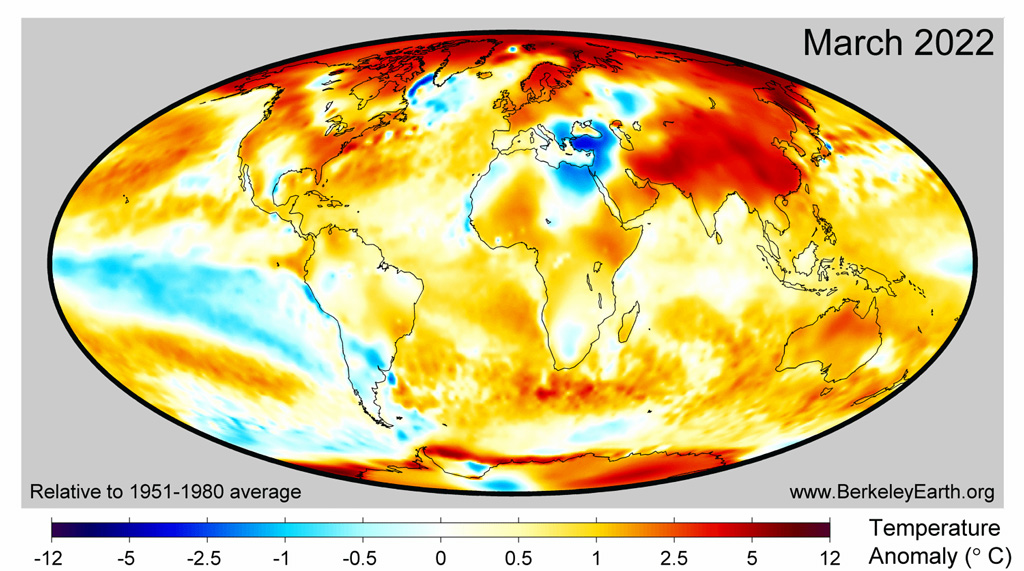
Portions of southern Asia – including much of China and India – experienced record warmth in March 2022. According to analysis by Berkeley Earth, 4.2% of the Earth’s surface had the hottest March on record, while 79% was warmer than during the 1951-80 baseline period used by Berkeley Earth. No location on Earth saw a record-cold March.
The most remarkable climate event of the first quarter of the year occurred in East Antarctica in March, where some regions experienced temperatures nearly 40C above normal for the time of year. The Dome C temperature station in Antarctica set a world record for the largest temperature excess above normal ever measured at a weather station, as shown in the figure below.
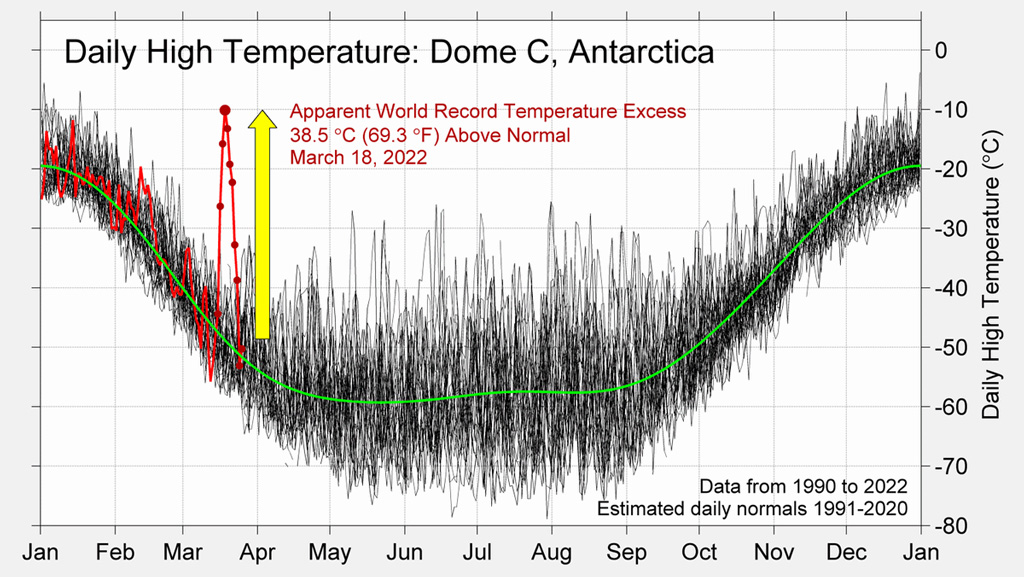
This event also coincided with record-low Antarctic sea ice cover and an ice shelf in East Antarctica the size of New York City collapsed into the ocean.
Climate models and observations
Climate models provide physics-based estimates of future warming given different assumptions about future emissions, greenhouse gas concentrations and other climate-influencing factors.
The figure below shows the range of individual model forecasts featured in the IPCC’s AR5 – known collectively as the CMIP5 models – between 1970 and 2030. The black line and grey shading indicate the average projection and spread, respectively, across all the models. Individual observational temperature records are represented by coloured lines.
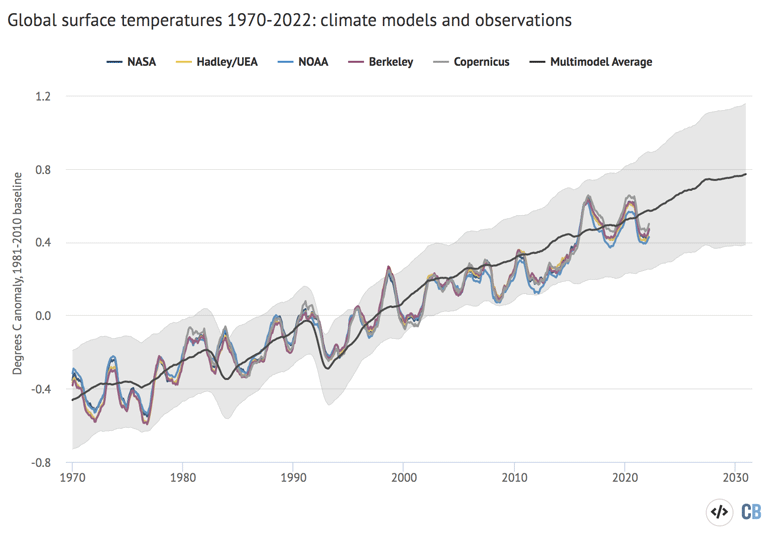
The latest generation of models – CMIP6 – are not compared to observations in this state of the climate report. The most recent report from the IPCC’s sixth assessment report (AR6) has changed the way that the ensemble of models is used. Rather than simply taking the average of all the models (and their range) – as was the case in previous IPCC reports – the IPCC decided to use a weighted subset of models that agreed well with historical observations. This also reflected a narrowing of climate sensitivity in the most recent IPCC report – such that a number of new models fall outside the “very likely” sensitivity range.
While the IPCC AR6 provided a new set of future “assessed warming” projections, these start in the year 2015, which makes comparisons with observations over such a short period not very informative. Carbon Brief will have more on this subject soon, including a discussion of how to best use CMIP6 model data consistent with the AR6 approach.
Sea ice
Arctic sea ice extent spent much of early 2022 at the low end of the historical 1979-2010 range, but only came close to setting a new record daily low in early March. There is generally less variability in year-to-year Arctic sea ice extent in the winter than in the summer, as cold winter temperatures refreeze large portions of the Arctic even in a warmer world.
Antarctic sea ice, on the other hand, was at or near record lows for all of 2022 to date. Late February saw the lowest Antarctic sea ice extent since records began, though the degree to which this was driven by climate change remains unclear given the lack of a clear long-term trend in the region – unlike in the Arctic, where sea ice declines are clearly driven by warming.
The figure below shows both Arctic and Antarctic sea ice extent in 2022 (solid red and blue lines), the historical range in the record between 1979 and 2010 (shaded areas) and the record lows (dotted black line). Unlike global temperature records (which only report monthly averages), sea ice data is collected and updated on a daily basis, allowing sea ice extent to be viewed through to the present.
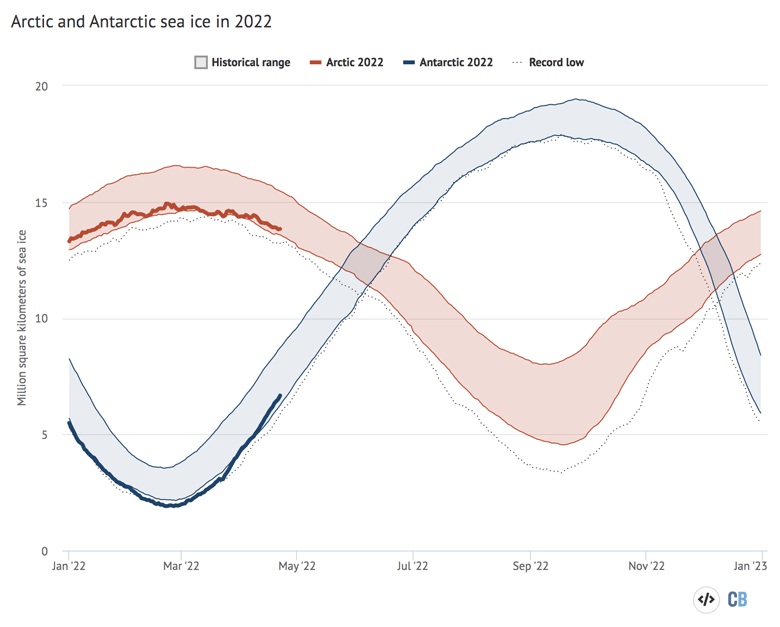
The summer Arctic sea ice minimum is a somewhat iconic figure and recent years have yet to drop below the record low set in 2012. While Arctic sea ice is on the low end of its historical range, it is still too early to know where the 2022 minimum will fall as winter extent is not a clear indicator of the summer minimum.
The chart below shows the average Arctic sea ice extent for each week of the year for every year between 1978 and 2021, with 2022 to-date highlighted with a thick black line.
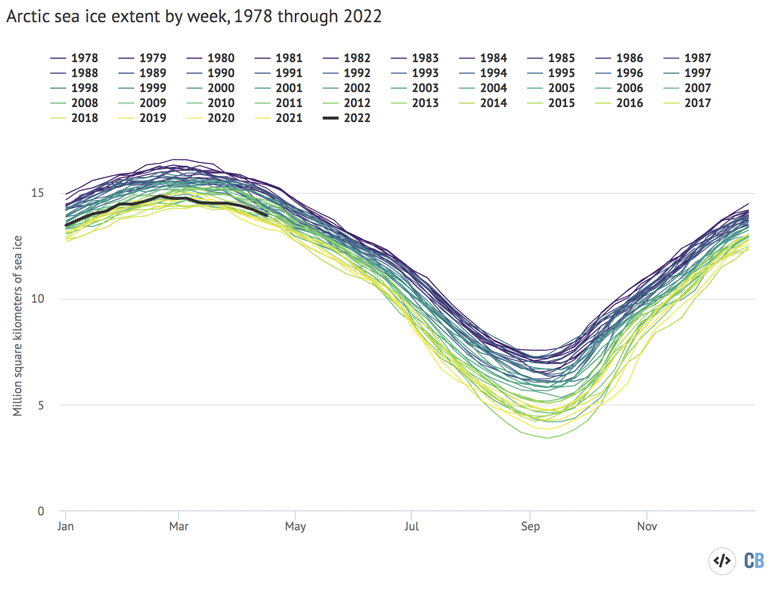
Finally, it is worth noting that sea ice extent only tells part of the story. In addition to declining ice extent, the sea ice that remains tends to be younger and thinner than ice that used to cover the region. The figure below, using data from the Pan-Arctic Ice Ocean Modeling and Assimilation System (PIOMAS), shows the Arctic sea ice thickness for every year between 1979 and 2022.
While sea ice volume is currently above its 2021 values, it is still well in-line with the long-term downward trend.
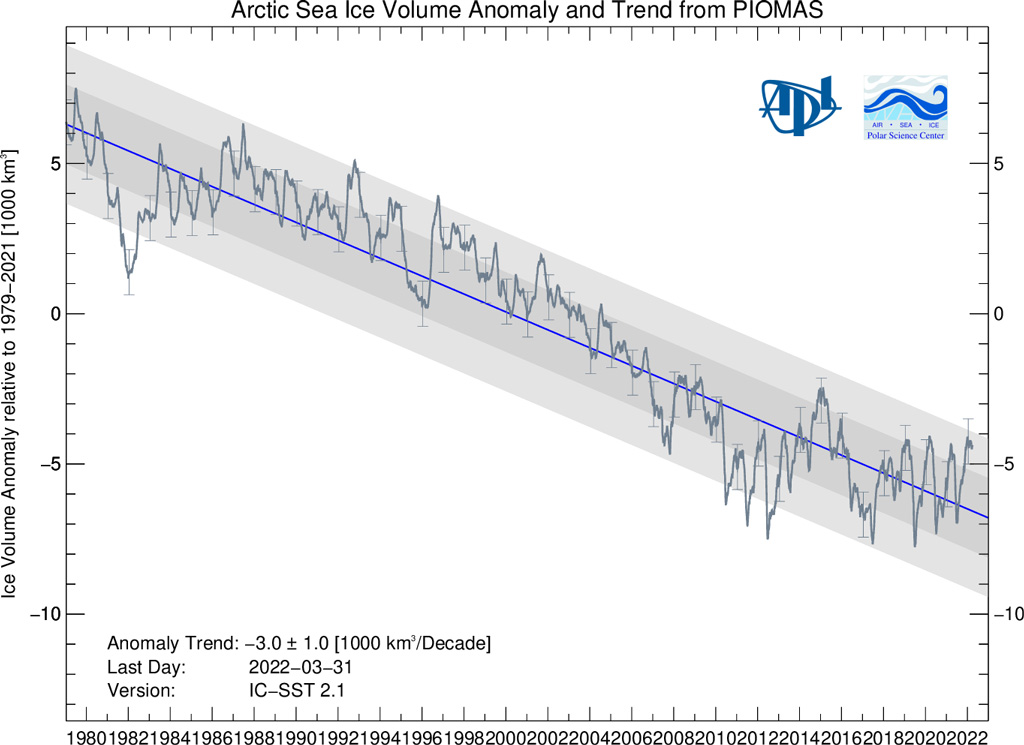
Where will 2022 end up?
The first three months of 2022 can give some sense of what to expect for the entire year. By looking at the relationship between the first quarter and the annual temperatures for every year since 1970 – as well as ENSO conditions for the first three months of the year and projected conditions for the remaining months – Carbon Brief has created a projection of what the final global average temperature for 2022 will likely turn out to be.
The analysis includes the estimated uncertainty in 2022 outcomes, given that temperatures from only the first third of the year are available so far.
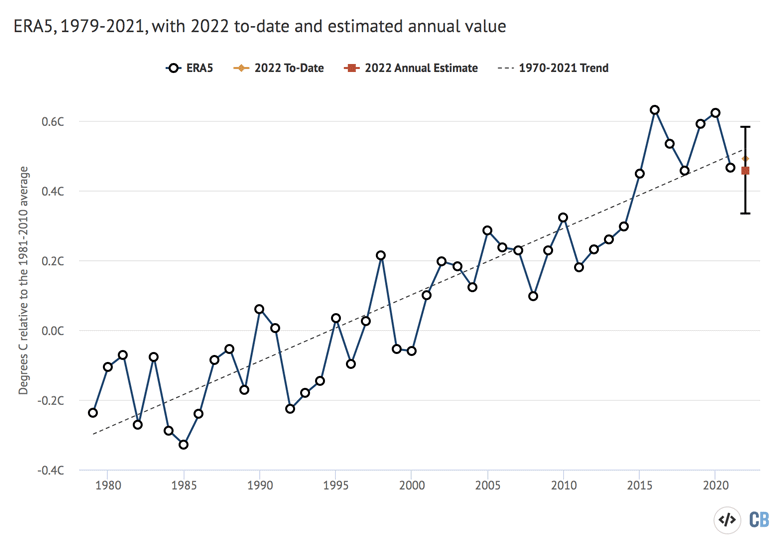
The projection suggests that 2022 has the best chance of ending up as somewhere between the fourth and eighth warmest year on record. Annual temperatures are likely to be a tad below what would be expected based on the long-term warming trend since 1970 – which is shown by the dashed line in the figure.
Carbon Brief provided a similar estimate of where 2022 temperatures would end up at the start of the year, prior to any 2022 monthly temperature data becoming available. The figure below shows this initial estimate, as well as ones made when January, February and March data were available.
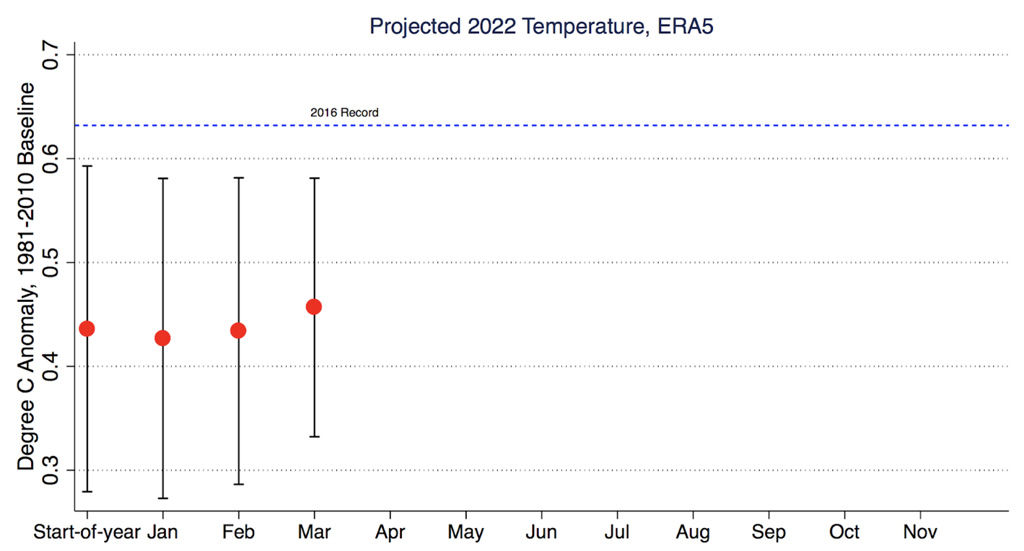
While it seems very unlikely that 2022 will be a record warm year for the world as a whole, it still may have many regional climate extremes in store. Not every year will set a new record due to short-term natural variability driven by La Niña and El Niño events, but the long-term warming trend marches on at around 0.19C warming per decade.

